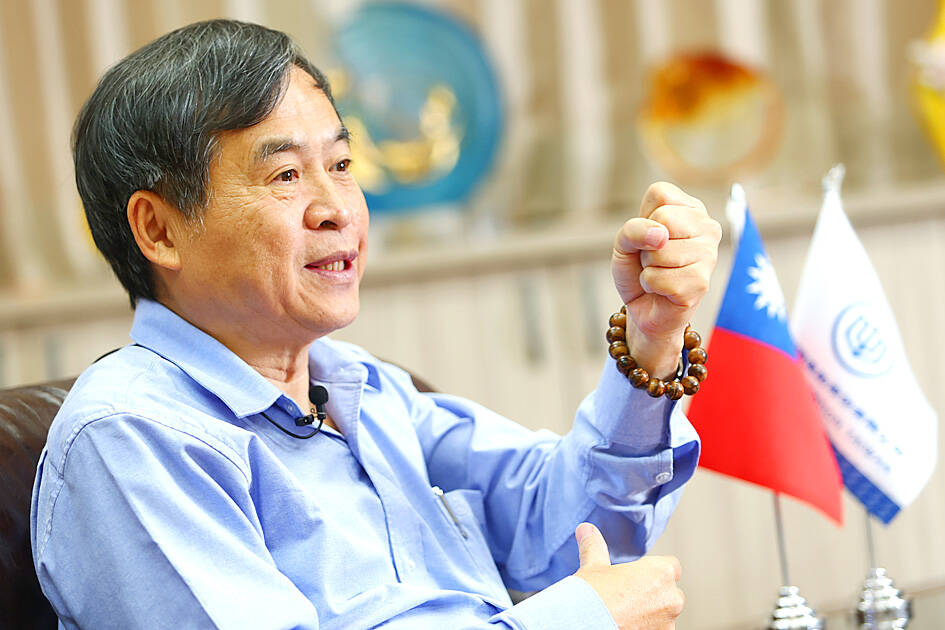CSBC Corp, Taiwan has been able to overcome some significant problems that arose while building a prototype of the nation’s first domestically made submarine, CSBC chairman Cheng Wen-lon (鄭文隆) said on Wednesday last week.
Earlier this year, Cheng said that the prototype would undergo final tests in September.
“We have been able to build 85 components locally so far,” Cheng said, after a source familiar with the program in January revealed that more than 40 percent of the submarine’s main body is being manufactured in Taiwan.

Photo: CNA
This would include airtight doors, a water conversion system, hydraulic system and a silent air-conditioning system, the source said.
Giving an example of how difficult it is to build a modern submarine, Cheng cited the need for silent toilets.
As Taiwan lacks experience building submarines, it had to procure 107 core technologies from overseas to build what is known as the “red zone” of the vessel, and manufacture the rest itself, he said.
Due to the silence required on submarines, Cheng’s team initially planned to import toilets costing NT$670,000 (US$21,744) each.
However, the price drew a public backlash, and the 990-member team in charge of building the submarine turned to local companies to manufacture the toilets for NT$150,000 each, he said.
The Ministry of National Defense has divided the hardware and technology needed to build a submarine into red, yellow and green categories, with red parts needing to be imported, yellow parts potentially made locally and green parts readily made in Taiwan.
Some red category technologies beyond Taiwan’s submarine design and building capability, such as diesel engines, torpedo tubes and other combat equipment, have been procured from overseas, the source said.
The construction of the prototype has continued around the clock since work started in 2020, Cheng said.
Other problems were overcome with the cooperation of the Naval Shipbuilding Development Center, the navy’s 256th Submarine Squadron, the Chungshan Institute of Science and Technology and a CSBC task force.
“We worked as partners rather than buyers and sellers,” he said.
After CSBC completes shipyard testing of the submarine in September, Cheng said the company would conduct harbor and sea operations tests before delivering the submarine to the navy.
Taiwan has allocated a NT$49.36 billion budget over seven years — from 2019 to 2025 — to build the prototype, with a plan to launch an indigenous submarine building program that would make it less dependent on other countries.
Such efforts could help Taiwan develop a national defense industry, and even enable the country to become a key submarine exporter, he said.
Although it has previously been reported that Taiwan is planning to allocate NT$300 billion to build a fleet of eight submarines as part of the Indigenous Defense Submarine Program, this has not been publicly confirmed by the military, and the ministry said such a plan requires further evaluation.

Taiwan is to commence mass production of the Tien Kung (天弓, “Sky Bow”) III, IV and V missiles by the second quarter of this year if the legislature approves the government’s NT$1.25 trillion (US$39.78 billion) special defense budget, an official said yesterday. Commenting on condition of anonymity, a defense official with knowledge of the matter said that the advanced systems are expected to provide crucial capabilities against ballistic and cruise missiles for the proposed “T-Dome,” an advanced, multi-layered air defense network. The Tien Kung III is an air defense missile with a maximum interception altitude of 35km. The Tien Kung IV and V

The disruption of 941 flights in and out of Taiwan due to China’s large-scale military exercises was no accident, but rather the result of a “quasi-blockade” used to simulate creating the air and sea routes needed for an amphibious landing, a military expert said. The disruptions occurred on Tuesday and lasted about 10 hours as China conducted live-fire drills in the Taiwan Strait. The Civil Aviation Administration (CAA) said the exercises affected 857 international flights and 84 domestic flights, affecting more than 100,000 travelers. Su Tzu-yun (蘇紫雲), a research fellow at the government-sponsored Institute for National Defense and Security Research, said the air

A strong continental cold air mass is to bring pollutants to Taiwan from tomorrow, the Ministry of Environment said today, as it issued an “orange” air quality alert for most of the country. All of Taiwan except for Hualien and Taitung counties is to be under an “orange” air quality alert tomorrow, indicating air quality that is unhealthy for sensitive groups. In China, areas from Shandong to Shanghai have been enveloped in haze since Saturday, the ministry said in a news release. Yesterday, hourly concentrations of PM2.5 in these areas ranged from 65 to 160 micrograms per cubic meter (mg/m³), and pollutants were

Taiwan’s armed forces have established response protocols for a wide range of sudden contingencies, including the “Wan Chun Plan” to protect the head of state, the Ministry of Defense (MND) said today. After US President Donald Trump on Saturday launched a series of airstrikes in Venezuela and kidnapped Venezuelan President Nicolas Maduro, concerns have been raised as to whether China would launch a similar “decapitation strike” on Taiwan. The armed forces regularly coordinate with relevant agencies and practice drills to ensure preparedness for a wide range of scenarios, Vice Minister of National Defense Hsu Szu-chien (徐斯儉) told reporters before a